IIZw28 is a small empty ring galaxy in Orion just east of the bottom of his shield. Rings of its type are thought to be caused by a small dense galaxy colliding with a disk galaxy almost perfectly face on like a bullet hitting a target. This blows the core to the edge of the ring. Usually, the "bullet" galaxy is quite obvious. Here there's no apparent "bullet" galaxy. Since the ring is thought to be a rather short-lived condition it should be nearby. One possibility is that the dense northern part of the ring is due to the superposition of the "bullet" galaxy and the displaced core. A note at NED says the galaxy has three distinct stellar populations; "...young stars in the ring, A-stars which are distributed inside the ring (this is strong evidence for the passage of the wave) and an old stellar population in the edge of the ring. It is thus very likely that the companion (is) seen in projection like in NGC 985." The mentioned NGC 985 is at -8 degrees and so far has been in too poor of seeing each time I tried for it. Maybe next year. It is more distant yet about twice the angular size of IIZw28. I measure the size of IIZw28 at 33,000 light-years so it is a small galaxy and target for the bullet galaxy to hit (maybe it has a lot of dark matter to draw in the bullet galaxy).
The field has quite a few distant galaxies in it but only 4 others have redshift data. Interestingly they appear in pairs. One pair close then IIZw28 at 220 million light-years and a more distant pair at 720 million light-years. NED identifies only a handful of other galaxies in the field. I've annotated all of them leaving the vast majority as unknown.
The northern galaxy at 220 million light-years carries the odd designation in NED as MS 0459.5+0327 Clump. I have no idea what is meant by "Clump". Its position had a rather large error bar so I can't tell if it is indicating the entire blue object or just the northern or southern part. To me, it appears to be two superimposed objects but may be one. Its size is smaller than the error bar of its position. The MS catalog is of objects discovered by the Einstein orbiting X-Ray observatory. The first true X-ray telescope put in space so it is no wonder the position is somewhat crude. In fact, it is darned accurate for the technology of 1978 when it was put into space. Apparently, there's been no followup on this object. At least I didn't find any.
This image is the result of several attempts from November 2013 through late January 2014. Seeing varied greatly. Since each color was taken a different night there's more color error in the star disks with various color fringes showing. This also made color correction difficult. I think it is correct in general but not up to my usual standards.
14" LX200R @ f/10, L=4x10' (best 4 of several dozen) RGB=2x10' (again best of many), STL-11000XM, Paramount ME | 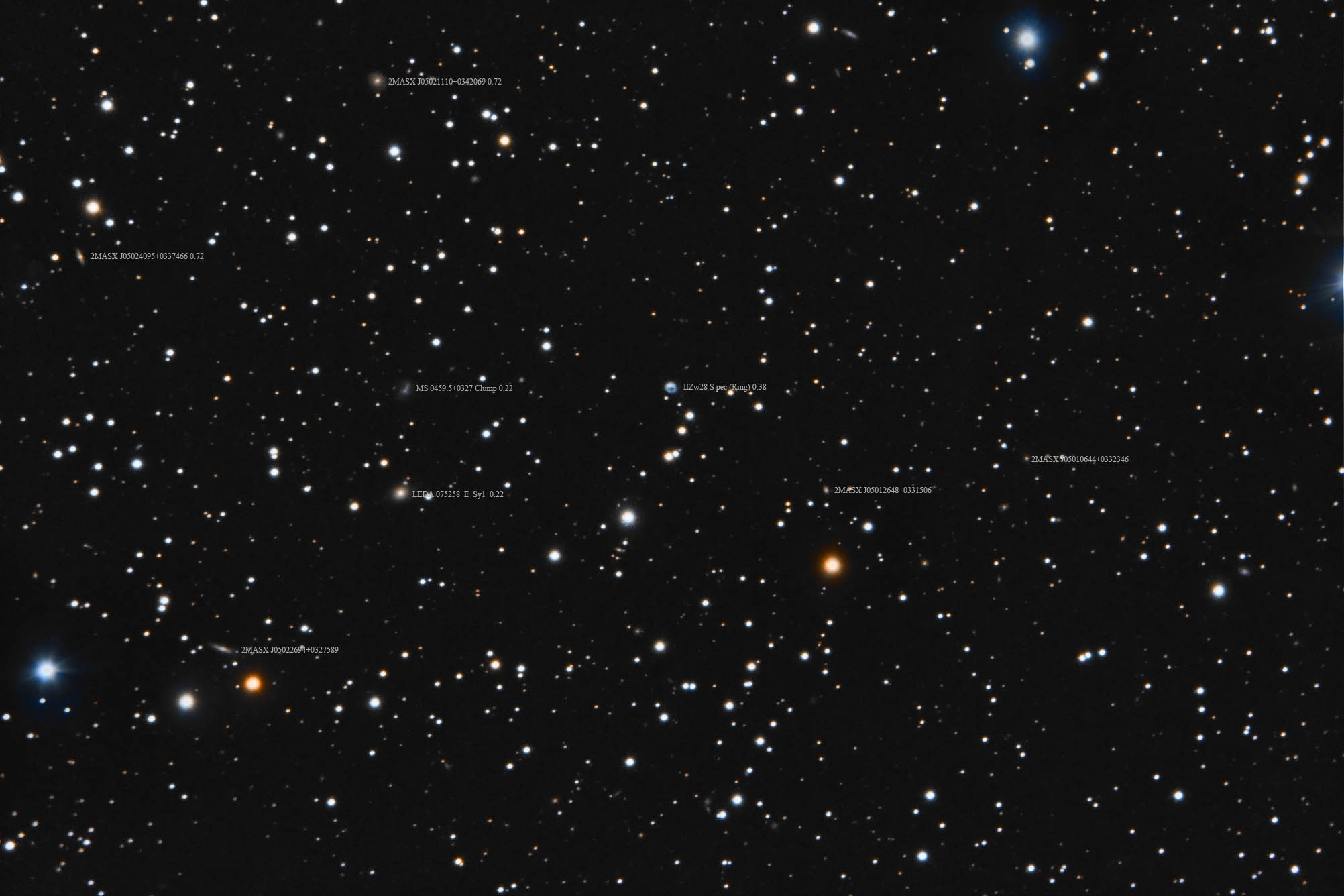
IIZW28L4X10RGB2X10-ID.JPG
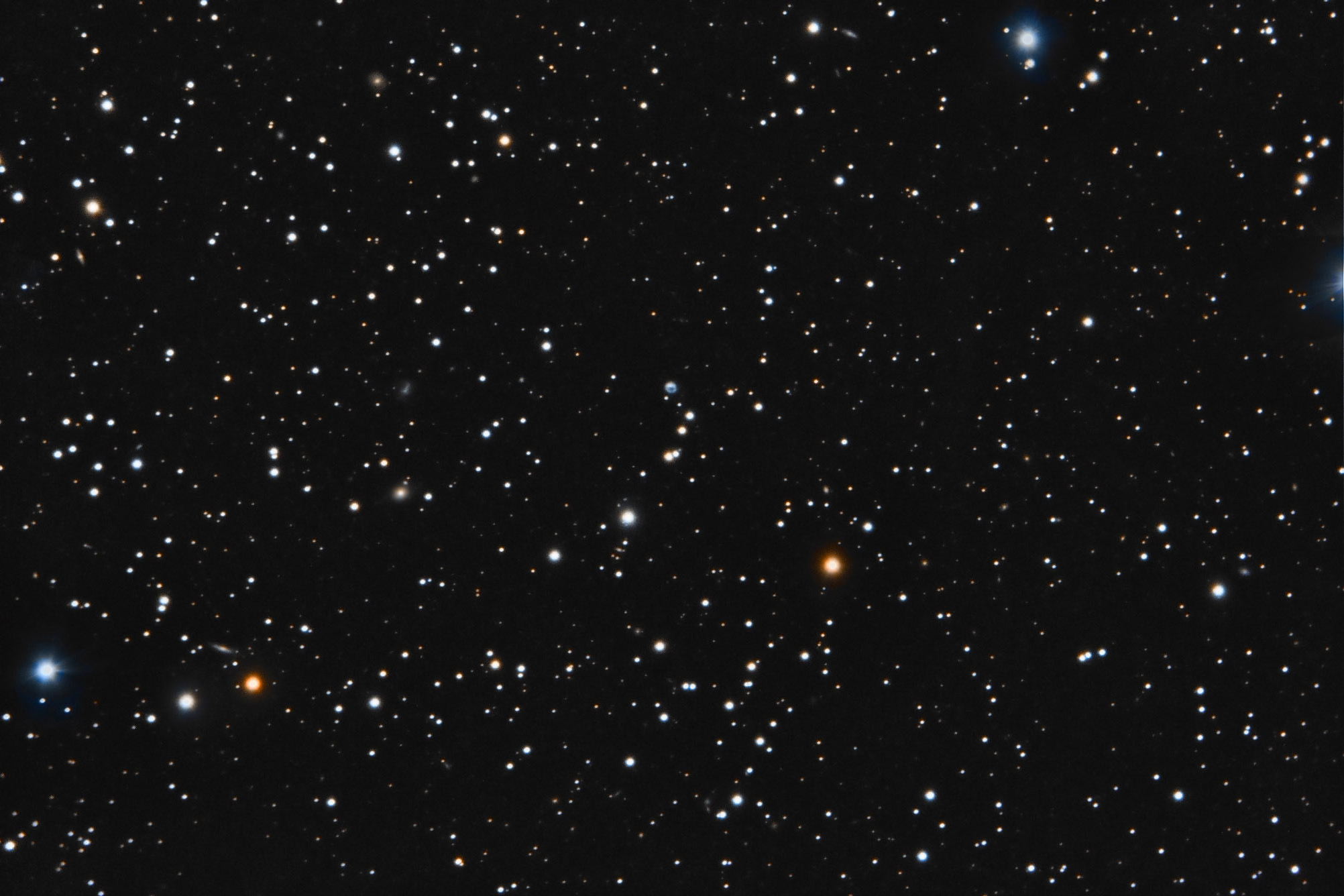
IIZW28L4X10RGB2X10.JPG
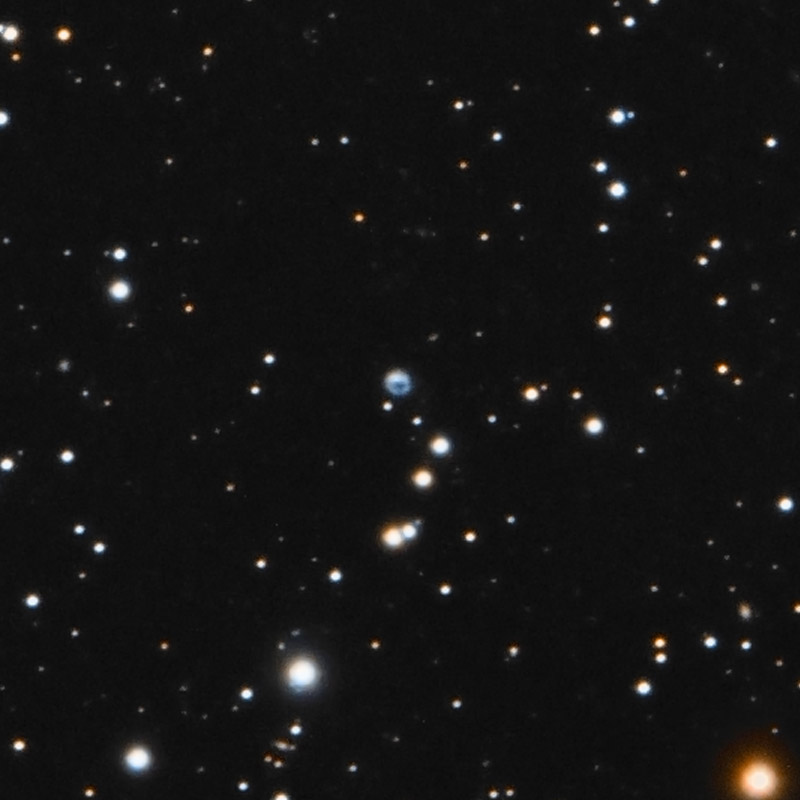
IIZW28L4X10RGB2X10CROP150.JPG
| IPHASX J200018+365934 also known as NeVe 2, is a planetary nebula candidate in the heart of Cygnus. The brilliant star that made processing this a nightmare is 25 Cygni, a B3IV 5th magnitude star. The image is so star-filled I couldn't get it below 1 meg in size. Finding the planetary candidate is almost a "Where's Waldo" challenge. Fortunately, it is 30" in size and not star-like. I see no central star but the blue disk with a red outer ring is sometimes seen in planetaries. It's hard to see it as anything else to my eye.
This one was brought up last July by a forum post asking what it was? Once I figured it out I added it to my short list of objects. Like most nights last summer neither seeing or transparency was very good but it was registering so I just gave it double my standard exposure time to make up for the horrid transparency. The first reference to it as a possible planetary nebula was in the Strasbourg-ESO Catalogue of Galactic Planetary Nebulae Strasbourg-ESO Catalogue of Galactic Planetary Nebulae in 1992. Then again in 2009 in this paper: http://adsabs.harvard.edu/abs/2009A%26A...504..291V . Apparently no definite answer to its nature is known as yet. It's one of several hundred such nebulae. An imaging task I doubt I'll undertake, I have too many on the to-do list as it is.
14" LX200R @ f/10, L=8x10' RGB=2x10', STL-11000XM, Paramount ME | 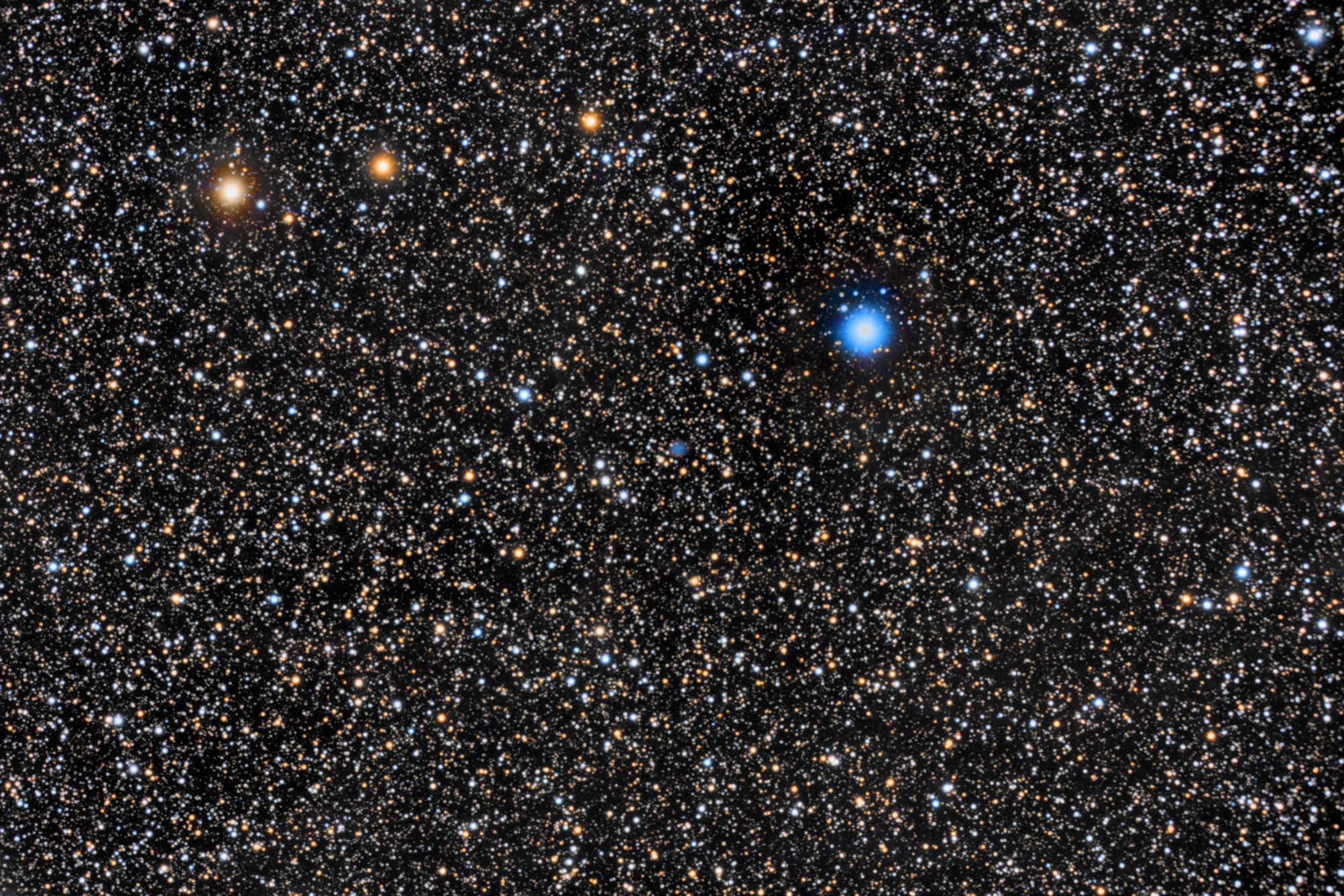
IPHASX J200018.7+365934L8X10-RGB2X10X3.JPG
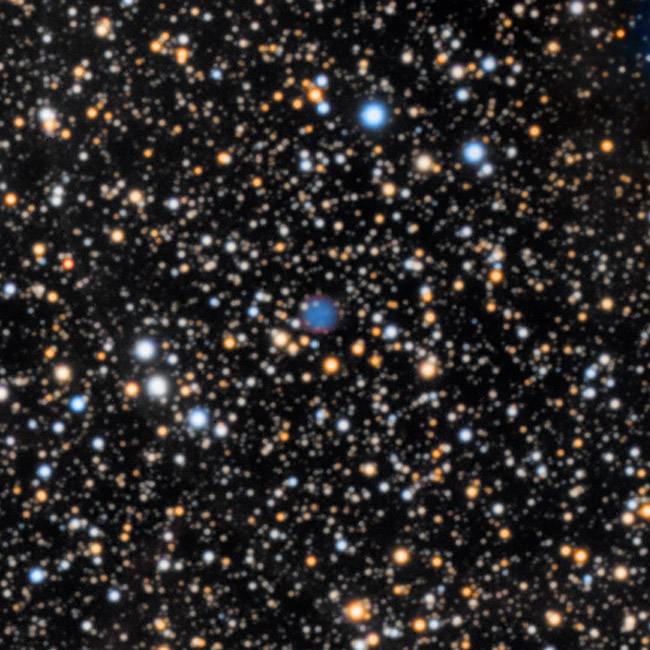
IPHASX J200018.7+365934L8X10-RGB2X10X3CROP150.JPG
| IRAS 20351+2521 is a nearly merged pair of galaxies in Vulpecula about 440 million light-years distant per redshift and 450 million light-years distant according to the HST write-up on this object. Including the large plume of new stars to the north, it is still only about 87,000 light-years across. NED classifies it simply as a spiral galaxy and notes it is a Luminous Infra Red Galaxy (LIRG). The strong IR in such galaxies is usually due to strong light from massive new stars buried in dust so their light is absorbed by the dust then re-emitted in the infrared region of the spectrum. While not always an indicator of galaxy interaction that is often what causes such star birth activity. The HST page on this one has little more to add but for a bit better resolved image of the galaxy at: http://www.spacetelescope.org/images/heic0810cb/
Residing on the edge of the Milky Way deep in the "Zone of Darkness" it resides in a very rich field of stars. The dust of our galaxy is obscuring distant galaxies as only a very few are seen in my image. NED lists a dozen visible at microwave frequencies (super deep IR) or very short radio frequencies, take your pick. None have any useful information for an annotated image so none was prepared.
Like much of this year conditions were poor as to transparency the night I took this image but fairly good as to seeing. Dawn limited me to one frame per color. I lucked out and space junk only hit the luminance frames so one frame was sufficient.
14" LX200R @ f/10, L=4x10' RGB=1x10', STL-11000XM, Paramount ME | 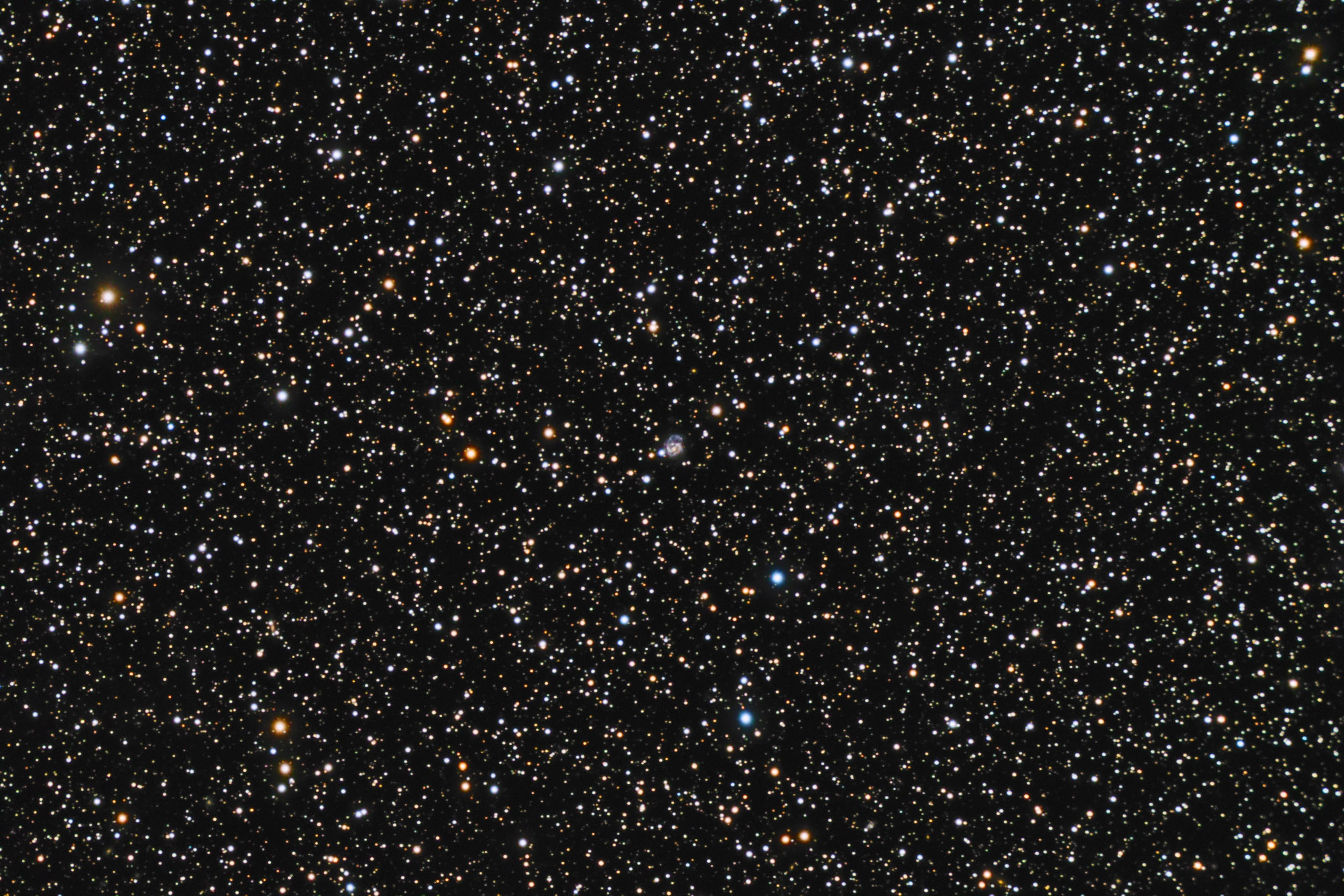
IRAS20351+252L4X10RGB1X10.JPG

IRAS20351+252L4X10RGB1X10CROP150.JPG
| This comet has been an impossible target for me living in the woods and my nearly constant clouds. It is low in the east deep in my neighbor's trees. It doesn't rise out of them until well into dawn. So this was taken under constantly brightening skies dimmed by the morning mist rising from the lake. This didn't help with color at all. Blue was mostly lost to blue skies of the rising sun and scattering of the mist. With only 12 minutes of data per channel, it is data starved for such bright skies. Doesn't help that seeing was poor as was transparency thanks to the mist. As it is moving east almost as fast as the sun the situation isn't improving much. Nor is the weather. All frames binned 3x3 to get as good of signal to noise as I possibly could under the conditions so the image is at 1.5" per pixel rather than my normal 1". To try and balance the fast brightening skies I took the frames L-R-G-B repeated 6 times rather than all of one at a time as I normally do. The green color is due to C2 emission, not CN as some websites have claimed. It may be more enhanced than it should be as the dawn sky had a lot of red and blue but no green that I saw.
The image was taken about 6:30 a.m. CDT on October 7, the only clear morning I've had without a moon sitting on top of the comet.
14" LX200R @ f/10, LRGB=2x6x3'each, STL-11000XM, Paramount ME Related Designations for ISONISON, | 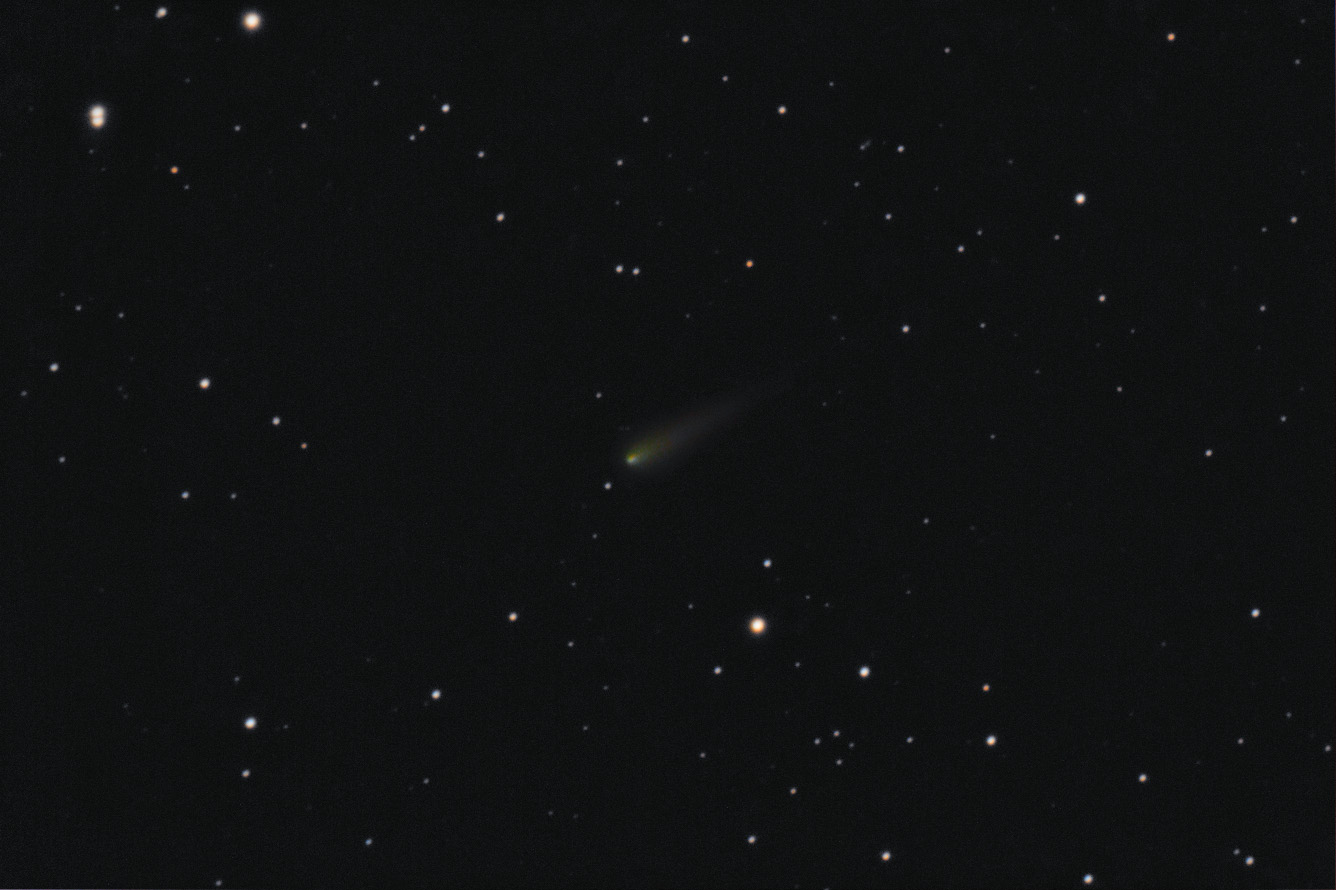
ISON_10-7_LRGB6X2X3.JPG
| Jones 1 is the common name in the U.S. for PK104-29.1. In much of the rest of the world, it is known as the Horseshoe Nebula. It is located in the constellation of Pegasus. This is a very large faint nebula barely seen in my 10" with an OIII filter. There aren't many images of this one on the net. Most of those are taken with OIII and H alpha filters. Many of those are of Jones Emberson 1 rather than Jones 1 indicating there is a lot of confusion over these two very different planetaries. I used just standard LRGB for my image and still was able to capture it quite well. There is a faint blob below it. I don't know if this is part of the planetary or not. H alpha images taken with a 3 angstrom filter to keep out NII, show it is H alpha, not the more common NII found in planetary nebulae. I was unable to find any reliable info on the distance to Jones 1. Only one comment that it was a bit over 2000 light years away but no source for this was given. Planetary nebulae are very hard to get good distance data on so this isn't surprising. Several stars are seen in its core. The blue one is the "white" dwarf that is causing the nebula to glow mostly in OIII light.
There's a probable quasar in the image below the nebula. I've pointed it out in the annotated image. When I made it I could find no distance. Now it is listed with a z value of 2.094. With so few significant digits I wonder if it is a photographic redshift. NED doesn't specify either way. If accurate it would translate to a look back time of 10.5 billion years. Meaning that's how long the light has been traveling to reach us. When the light left the universe was much smaller than today. The quasar was only 5.7 billion light-years away at the time. The ever expanding universe meant the light had to travel further and further to reach us, nearly needing twice the time its distance would imply. But that was then. Now the universe is much larger, so much larger the object is now further away than the 10.5 billion light-year travel time would indicate. In fact, it is likely about 17.6 billion light-years away. That is greater than the edge of the observable universe which is a bit less than 14 billion light-years. So in the 10.5 billion years, the light took to reach us, the quasar moved 17.6-5.7 or 11.9 billion light-years. This may seem it is exceeding the speed of light but it isn't violating Einstein's rule. That doesn't limit the rate of expansion of the universe.
14" LX200R @ f/10, L=6x10' RGB=2x10x3, STL-11000XM, Paramount ME Related Designations for JONES1JONES1, | 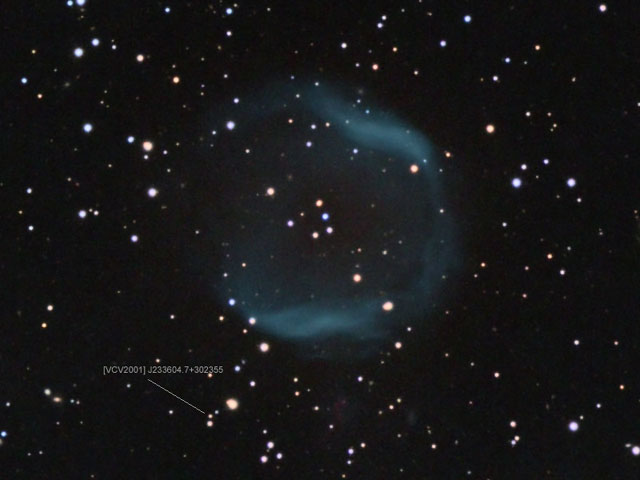
JONES1LUM6X10RGB2X10X3-id.jpg
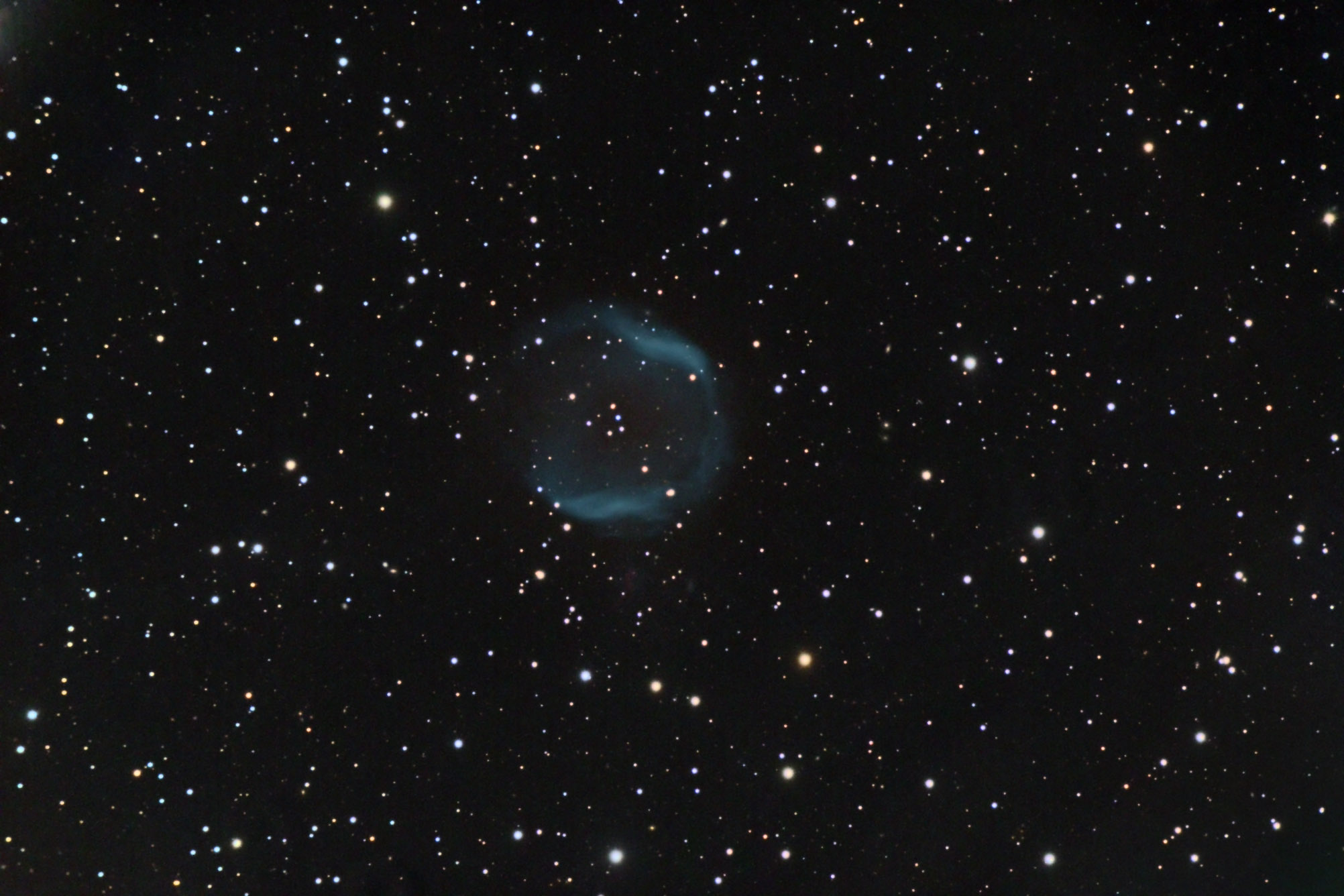
JONES1LUM6X10RGB2X10X3.jpg
| Kohoutek 1-14/K1-14 is an interesting planetary nebula in Hercules. Its central star is a double star with a separation of only 0.34". The star is off center in the planetary and nearly hidden by a much brighter field star a bit over 2" away. It is uncertain if the off-center central star is due to effects of the companion or due to the interstellar medium moving the nebula in relation to the star. Kohoutek cataloged this and other planetary nebulae in about 1963 from an examination of the Palomar Observatory Sky Survey plates taken with the 48" Schmidt camera.
Seeing was rather poor when I took this image. I was unable to separate the central star from the much brighter field star. It just shows as a blue tinge on the southwestern side of the field star. I need to try again on a much better night.
14" LX200R @ f/10, L=4x10' RGB=2x10', STL-11000XM, Paramount ME Related Designations for K1K1, 14, | 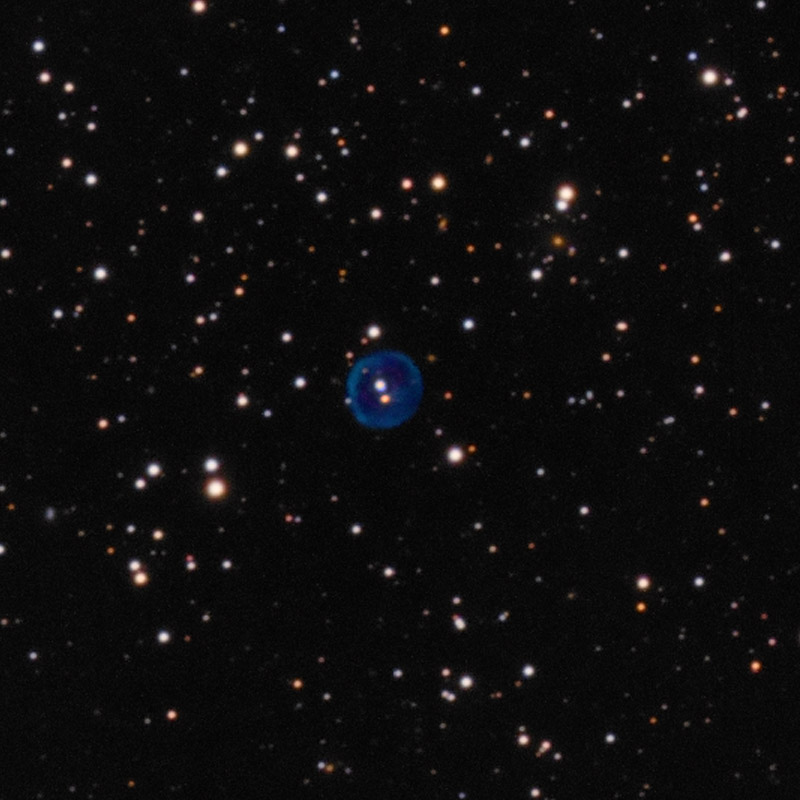
K1-14L4X10RGB2X10R-CROP150.JPG
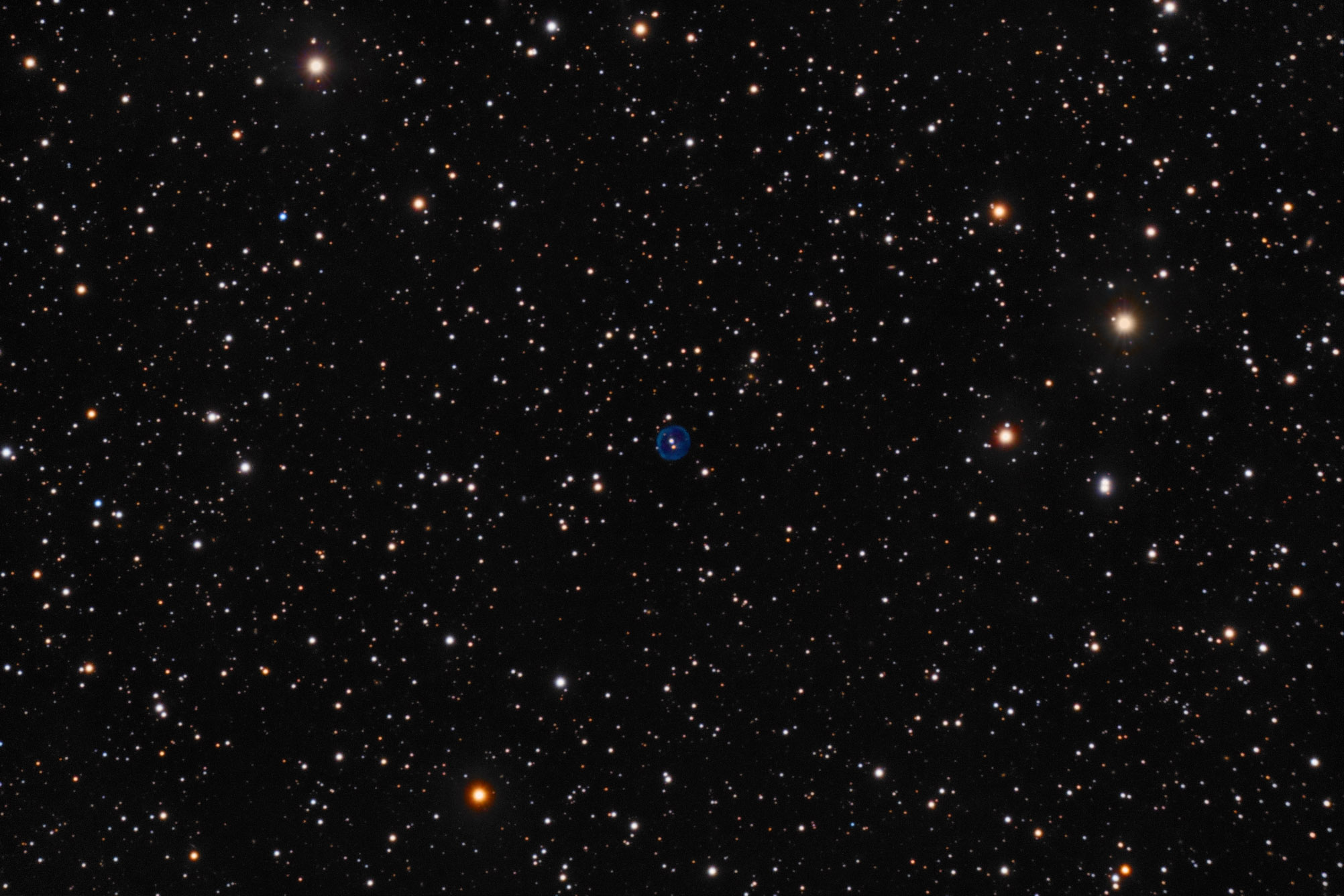
K1-14L4X10RGB2X10R.JPG
| Back on November 28, 1967 a grad student, Jocelyn Bell, discovered something very odd in the data of a radio object. No one could explain the emissions that pulsed with a regularity of an atomic clock and thus far beyond anything ever seen in the skies. No one could understand what it was and some fell back to the old, even then, pseudoscience argument from ignorance, since it isn't anything we can explain it may be due to aliens idea and some even started calling it LGM for Little Green Men. It turned out it was the first known pulsar of which we know of thousands. In a case of "Déjà vu all over again," we now have a star seen in the Kepler data hunting for planets, KIC 8462852 to use the Kepler Input Catalog number (it's Yale number is TYC 3162-665-1), with brightness variations that no one can explain. So far there are major problems with all astronomical explanations. So again falling back to the pulsar era the alien possibility is again being toted out. Yes the pulsar could have been an alien signal but wasn't. This too could be due to alien activity but I suspect it will again herald the discovery of something new in astronomical knowledge maybe opening up a whole new field of study as the pulsar has (will it get a watch named for it?).
Last night was the first night I had a hope of imaging it since it was announced. All I had were sucker holes but after 4 hours of trying, I finally got enough data to put a quick image together. I found no spectroscopic classification for it but with a B-V value that ranged around .5 to 1 (sources varied greatly) I expected a slightly red star but instead got a slightly blue one. I found no color image of the field but for one put together from the POSS data's red and blue plates by Aladin. That too showed it slightly blue. Now I'm confused. I doubt this has anything to do with the odd deep dips in the light curve of this star as these various measurements were random and highly unlikely to hit one of the dips in the curve. But I found nothing on how its color did change during a dip. So, for now, this is yet another mystery. I suppose somehow the clouds going by altered my color data but after calibration using NOMAD data the other stars all appear correct, this one is the exception. Also, I grabbed three short exposures (10 seconds) during an apparently clear sucker hole and it showed the same slightly blue color. So I'm quite confident the color is correct, at least for last night. I took many color frames, all but one of each color hit by clouds, so only used the cloudless color frames. If it stays clear tonight I'll try again for better color.
For more on this star including the strange light curves that started all this, see Phil Plait's article on it http://www.slate.com/blogs/bad_astronomy/2015/10/14/weird_star_strange_dips_in_brightness_are_a_bit_baffling.html Another good article on it is in the Washington Post http://www.washingtonpost.com/news/morning-mix/wp/2015/10/15/the-strange-star-that-has-serious-scientists-talking-about-an-alien-megastructure/?wpmm=1&wpisrc=nl_p1wemost
At 12th magnitude, a large Dob might show color. If so I'd like to know what color you see it as. I saw no color in my 14" but then my eyes aren't what they used to be either. I used far less stretch than normal to suppress the great number of faint stars that made the field a mass of stars. It's position is 20h 06m 15.45" +44d 27' 24.8".
The field is full of stars, many of which Kepler has studied. The star is the slightly blue one in the center of the image. I've marked it in the cropped image.
Edit: Since this was written studies in both IR and UV light indicate the small dips are caused by a dust ring about the star. This also could account for the long-term fading that is seen. It may even account for the short-term brightenings seen. But it can't easily account for the very deep (up to 20%) fast dips Kepler saw. None have been seen since Kepler had to stop watching this field so haven't been studied.
I've reproduced this one at 1.5" per pixel as my usual 1" per pixel adds nothing useful.
14" LX200R @ f/10, L=4x10' RGB=1x10', STL-11000XM, Paramount ME | 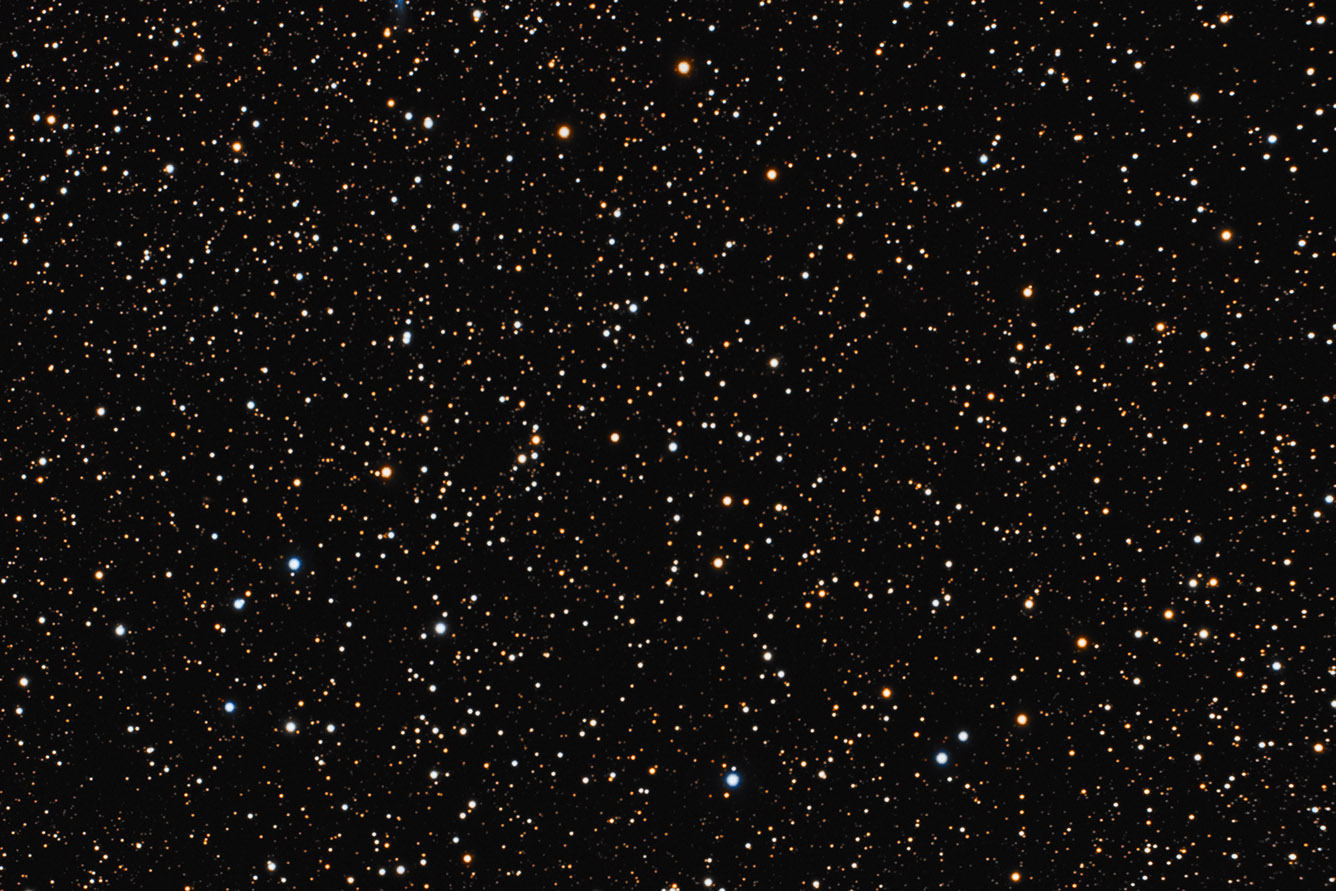
KIC8462852L4X10RGB1X10-67.JPG
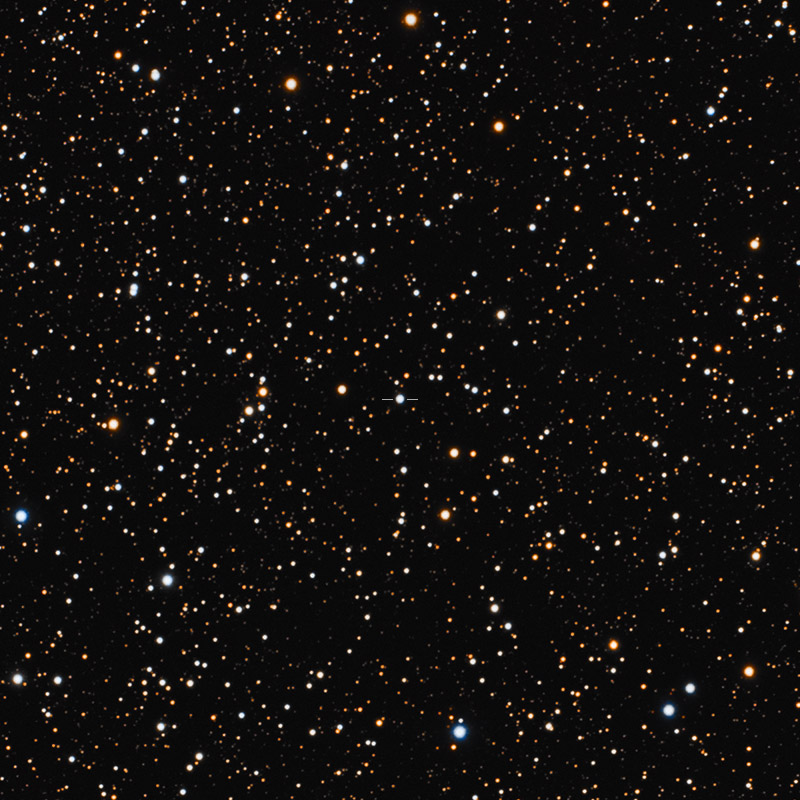
KIC8462852L4X10RGB1X10-67CROP.JPG
| King 5 is an open cluster in Perseus. Being in the winter Milky Way it is in a rather rich star field. Not nearly as rich as the summer Milky Way however since we are no longer looking inward toward the core of our galaxy where most stars reside but more outward toward the suburbs so see fewer stars. Most stars in the Milky Way are small red dwarf stars. Most of the stars we see with the naked eye are giant stars and most of those are blue in color since those that are red are dying and won't be around very long. Though giant blue stars can be short-lived those that are only bluish last a few hundred million years so to make up the majority of the bright stars we see. This is seen in this image as well. The few bright stars are blue, most of the rest dim orange-red stars. Every red dwarf star ever created is still alive today unless it collided with another star -- extremely rare so its safe to say 99.9999% of all red dwarf stars are still around. Thus by sheer number, they dominate by number but not by light. Even their masses can't outshine the few massive blue giants that form the spiral arms of galaxies. Thus we see most spiral galaxy arms as somewhat blue in color even though that color is created by the smallest population of stars.
The King catalog of star clusters is small. There are only 26 members and #3 is missing or a duplicate of NGC 609, depending on who you wish to believe. Nearly all King clusters reside in a narrow band about 50 to 60 degrees North declination and are in the Milky way running from about 23 hours R.A. to 3 hours. So they are in a rather small area of the sky. It appears King made three searches for previously unknown clusters as the catalog runs from 0 through 24 hours, then does so again, then does so again. Each time picking up less obvious clusters. Some may not even be true clusters. One is actually well below the celestial equator. It must be the outcast member of the group. Anyway, I happened to need something in the only clear spot on the sky one night and this was the object. Not needing a lot of exposure time I started to image it. The sky clouded over then cleared then clouded then cleared. With the poor sky I just kept imaging and ended up with my normal exposure time but it was visible only about 20% of the time. The rest of the time I was seeing nothing but clouds. So this image doesn't go very deep compared to my normal images but is rather pretty. The cluster is estimated to be about 6000 light years from us. Distances to such clusters are not easily measured so this is only a rough estimate. Like all King clusters, it is made up of faint stars so not a cluster to see visually unless you are using a 20" or larger telescope. Also, it is rather small in size compared to most M and NGC open clusters. Not surprising since they were missed by earlier visual surveys. It took the Palomar Observatory Sky Survey plates to let King even find these few overlooked clusters.
14" LX200R @ f/10, L=4x10' RGB=2x10', STL-11000XM, Paramount ME Related Designations for KING05KING05, | 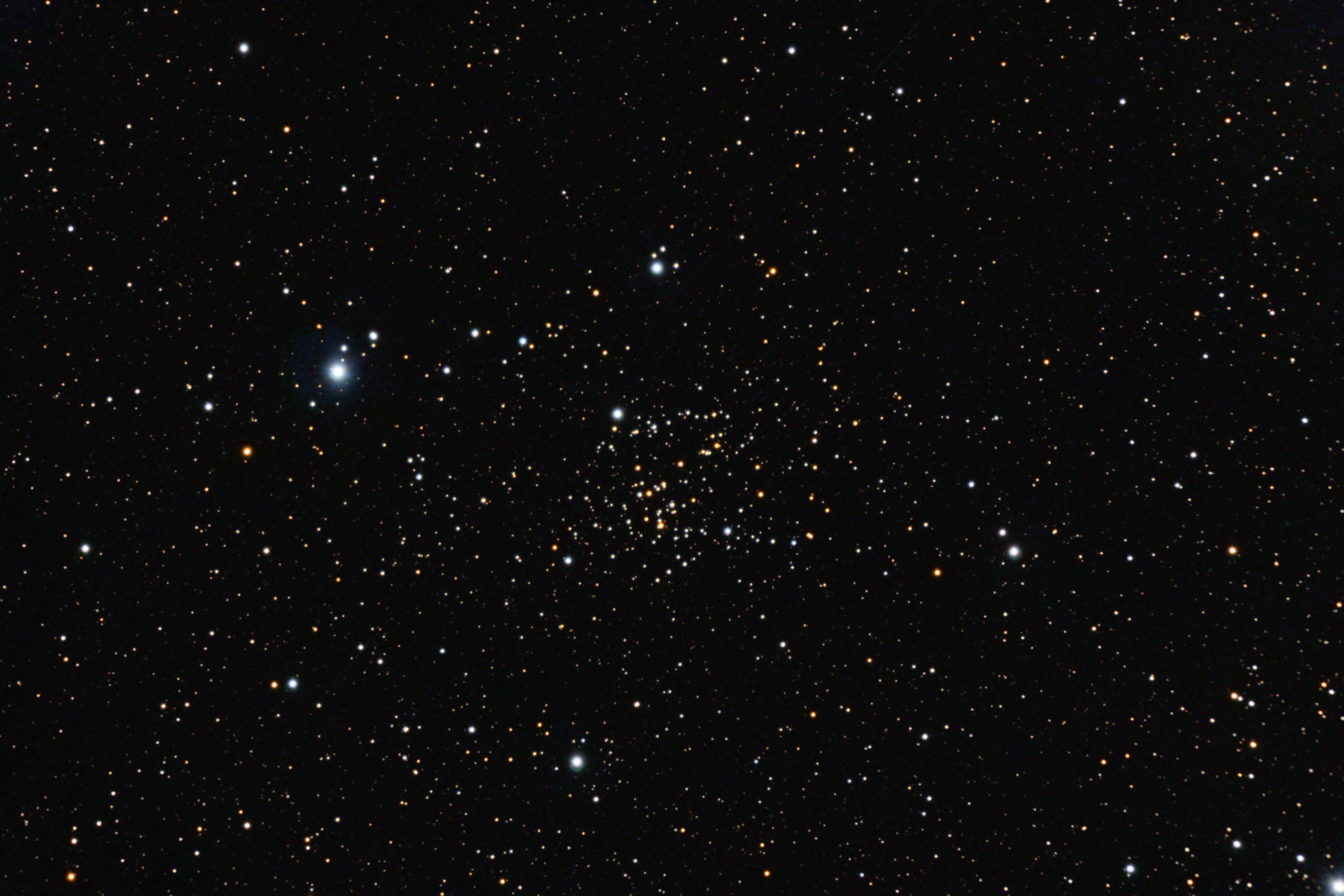
KING5L4X10X2RGB2X10X3R.jpg
| King 10 is an open cluster in southeastern Cepheus. The eastern border of Cepheus with Cassiopeia runs along the eastern edge of my image. WEBDA puts its distance at 11,000 light-years and its age as only 28 million years making it very young. Though the stars don't appear all that blue as would be expected at its age. This is because it is reddened by galactic dust by 1.14 magnitudes according to WEBDA.
I suspect the bright blue stars in the image are all much closer and out of the reddening dust. 5 of them to the southeast of the cluster make a gentle arc with the leftmost being the brightest. Now go back one star from the left end. There's a faint reflection nebula below and to the left of it. That is listed at SIMBAD as Saloranta GN J2256.0+5906. It was discovered during a survey looking for previously unknown open clusters. One of the authors is a J. Saloranta is you were wondering where that name came from. The survey was published in March of 2006.
No, I didn't realize it was there when I took the image. If I had of known I'd have used a lot more exposure as it is barely above my noise level. It appears there's a large even fainter blue cloud running north and south through its position but I'd need a lot more time to verify it. The paper can be found here https://www.aanda.org/articles/aa/pdf/2006/09/aa4057-05.pdf but doesn't mention the nebula other than to say some were found that need additional follow-up. I've not found anything further but SIMBAD indicates this is where the nebula was first mentioned. Table 3 does list some of these but not this one.
Note that if you search SIMBAD for this nebula be sure to ask only for it. If you ask for things around it, it will return a not found or other error message depending on how it feels that day. You can do a coordinate search 22h 56m 04.3s +59d 06' 10" for it and things around it.
14" LX200R @ f/10, L=4x10' RGB=2x10', STL-11000XM, Paramount ME Related Designations for KING10KING10, | 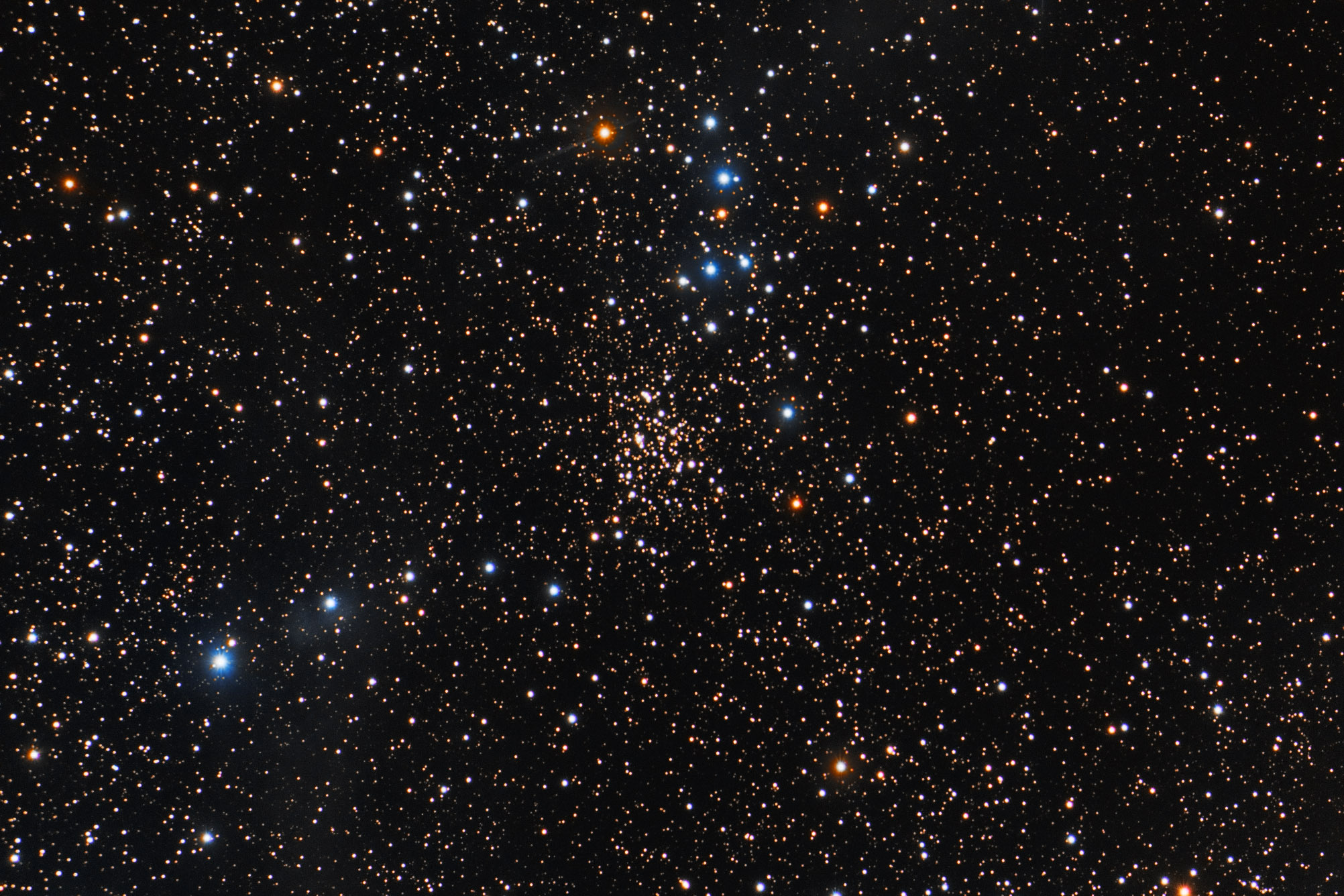
KING10L4X10RGB2X10.JPG
| The messy blue galaxy is kkh 003. NED classifies it as an irregular galaxy but adds a question mark indicating this is, well, questionable. It is located in northwestern Cetus about 170 million light-years distant It contains three blue star clouds almost in a line on its west side. NED refers to these as separate galaxies. Redshift for the upper two is virtually the same as for kkh 003 indicating they are really part of the galaxy. The lowest one has no redshift but I see no reason to assume it too is just a star cloud in the galaxy. It seems to have two faint horns going northeast from either side of the galaxy. I didn't see these in the POSS image I used when deciding to add it to my to-do list. If I had I'd have used more time to help bring them out. I already used twice my normal luminance data but it needs even more. Unfortunately, this one has no research on it other than basic parameters. To me, it looks possible it is the result of a merger. Note that's just possible. It may just be a rather ordinary blue irregular galaxy. One source called it a dwarf irregular. But if you include the faint "horns" it is about 50 thousand light-years in size which is rather large for a typical irregular galaxy, one reason I'm considering it being due to a merger. Another is due to the horns which could be plumes ripped from galaxies it has consumed. Pure conjecture on my part as I found nothing on this anyplace.
The kkh catalog is what the authors, Karachentseva, Karachentsev and Huchtmeier found from the Palomar plates that they interpreted to be rather nearby dwarf galaxies. That would be true of kkh 003 if it were that close but it is nearly 6 times that distance and thus not a dwarf though it sure looks like one. Redshift data for most of these were not available at the time of the catalog so errors like this aren't surprising. While the catalog is named for the authors, NED lists it in lower case so I followed their example.
The annotated image includes all galaxies, quasars and candidate quasars NED had on its site.
14" LX200R @ f/10, L=8x10, RGB=2x10, STL-11000XM, Paramount ME | 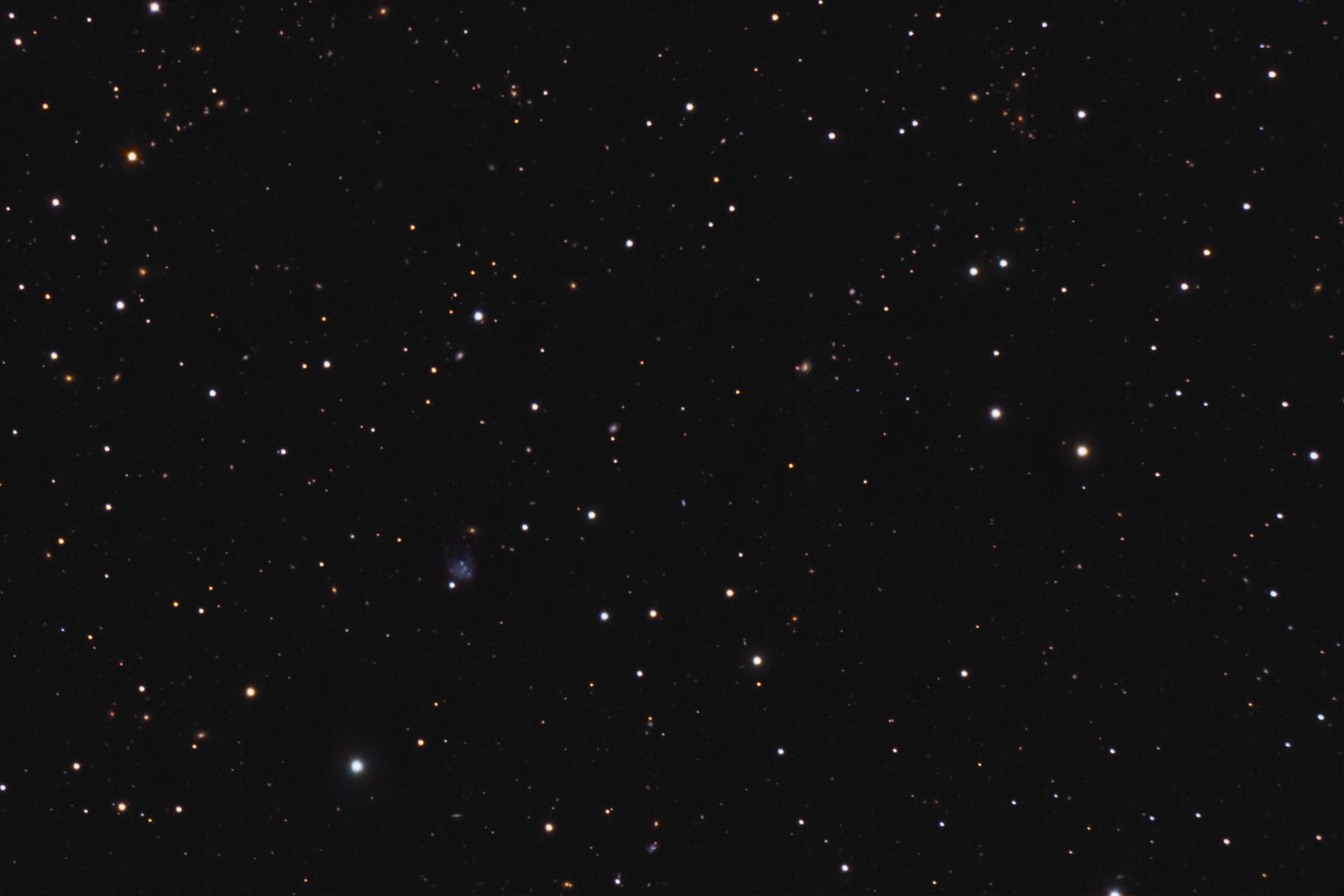
KKH3L8X10RGB2X10.JPG
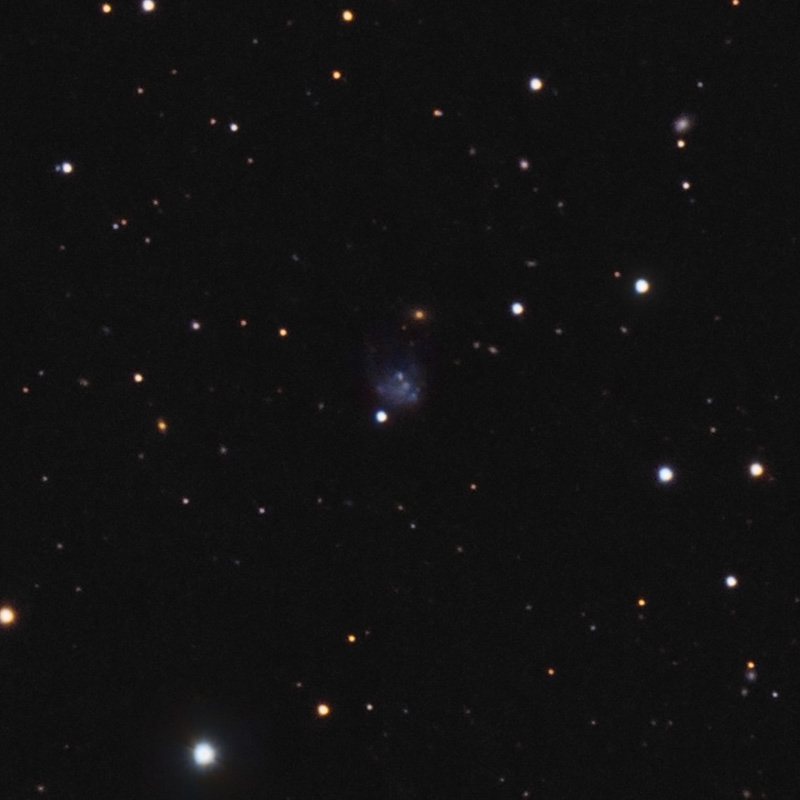
KKH3L8X10RGB2X10CROP125.JPG
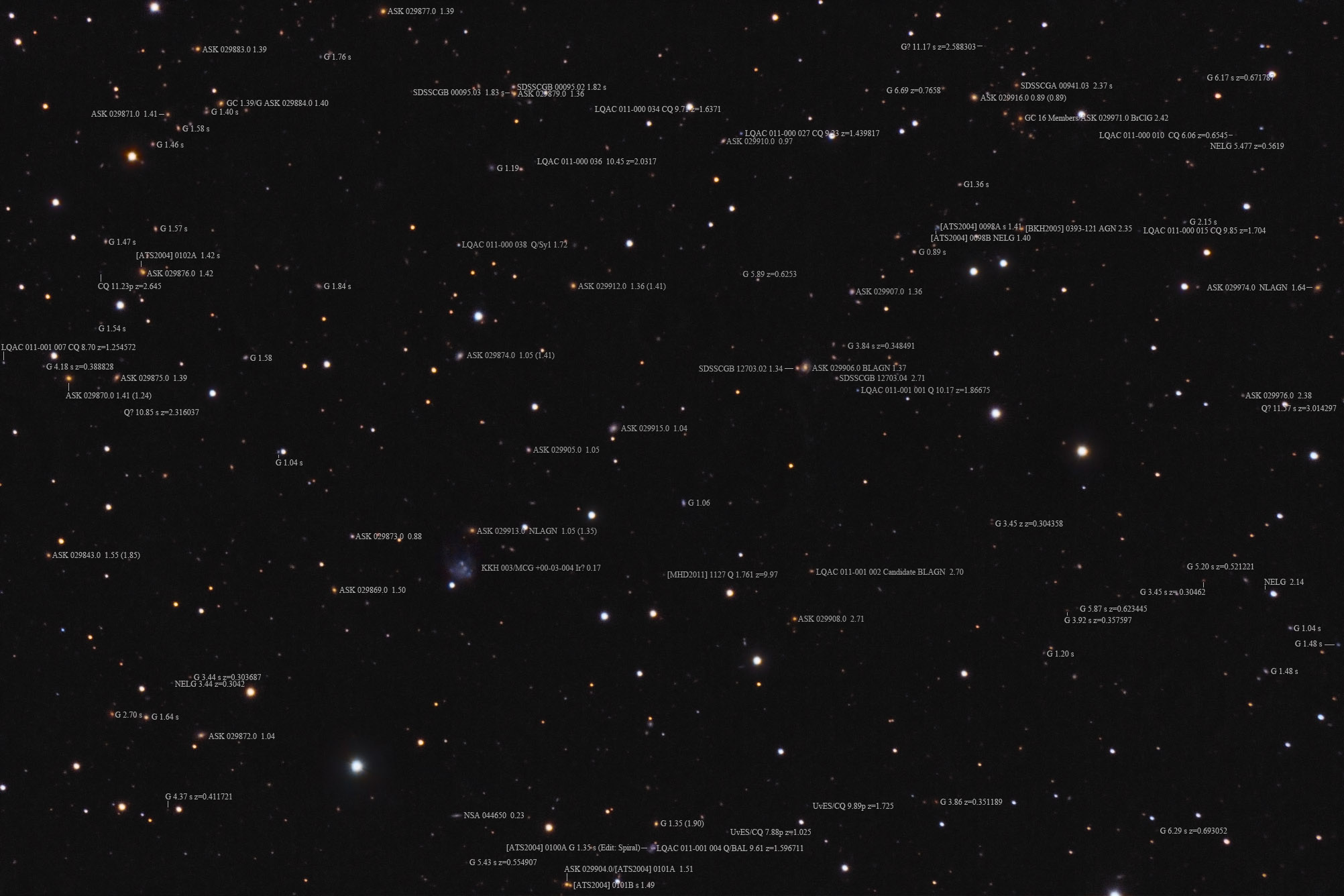
KKH3L8X10RGB2X10ID.JPG
| 

















